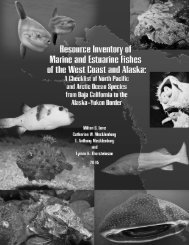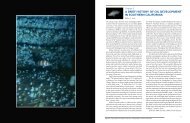Reproductive Ecology and Body Burden of Resident ... - The Love Lab
Reproductive Ecology and Body Burden of Resident ... - The Love Lab
Reproductive Ecology and Body Burden of Resident ... - The Love Lab
You also want an ePaper? Increase the reach of your titles
YUMPU automatically turns print PDFs into web optimized ePapers that Google loves.
ture <strong>and</strong> salinity on otolith elemental uptake rates, Elsdon <strong>and</strong> Gill<strong>and</strong>ers (2002) <strong>and</strong> Martin <strong>and</strong> Thorrold<br />
(2005) suggested that uncontrolled variation <strong>of</strong> Mn in experimental treatments may have confounded<br />
results. Martin <strong>and</strong> Thorrold (2005) suggested that bacterial growth in the treatments may have served as<br />
microbial catalysts forming manganese oxides that were scavenged onto particles lowering dissolved Mn<br />
concentrations in ambient waters. It is possible that the particle scavenging rate <strong>of</strong> Mn by bacteria in the<br />
bottom waters <strong>of</strong> the westernmost areas <strong>of</strong> our study area may have been higher than the other areas.<br />
In contrast, under anoxic aquatic conditions, the availability <strong>of</strong> dissolved Mn Ca -1 for uptake by fish<br />
can increase. Dorval et al. (2007) found that Mn Ca -1 in otoliths <strong>of</strong> spotted seatrout (Cynoscion nebulosus)<br />
was positively correlated with Mn Ca -1 in Chesapeake Bay waters but the relationship was not significantly<br />
linear. Dorval et al. associated the field observations <strong>of</strong> concentrations <strong>of</strong> biologically available Mn (Mn +2 )<br />
in ambient waters peaking in particular locations due to the reduction <strong>of</strong> oxidized Mn during summer when<br />
anoxic conditions dominate bottom water <strong>and</strong> surface sediment. Another explanation for our observations<br />
<strong>of</strong> otolith Mn Ca -1 differences among areas may be that the Mn reduction rate may be higher in bottom<br />
waters <strong>of</strong> the eastern Channel <strong>and</strong> Southern California Bight if waters are relatively anoxic compared to the<br />
western areas <strong>of</strong> our study.<br />
Forrester <strong>and</strong> Swearer (2002) found no relationship between Mn concentration in otoliths <strong>and</strong> sediments<br />
within bays <strong>of</strong> the Southern California Bight; however, we cannot rule out differences in the Mn load<br />
in sediments in our study that may have contributed to the differences otolith chemistry among areas that<br />
we observed.<br />
In summary, our results showed that the elemental concentrations <strong>of</strong> some elements in the otoliths <strong>of</strong><br />
kelp rockfish <strong>and</strong> Pacific s<strong>and</strong>dab differed between platforms <strong>and</strong> natural sites sampled in the Santa Barbara<br />
Channel <strong>and</strong> Southern California Bight; however, the differences were not always consistent among<br />
geographic areas. Kelp rockfish collected from platforms tended to incorporate higher concentrations <strong>of</strong><br />
Mg <strong>and</strong> Ba <strong>and</strong> lower concentration <strong>of</strong> Sr in otoliths compared to fish from natural habitat. In comparison,<br />
Pacific s<strong>and</strong>dab collected from platforms tended to have lower concentrations <strong>of</strong> Ba <strong>and</strong> Fe in otoliths compared<br />
to fish from natural habitat. Mn Ca -1 , in otoliths <strong>of</strong> Pacific s<strong>and</strong>dab, was the only element in otoliths<br />
<strong>of</strong> either species that showed a well-defined pattern in its distribution among collection areas. Mn Ca -1 was<br />
not detectable in kelp rockfish otoliths. Variability in otolith element concentrations between habitat types<br />
<strong>and</strong> among areas differed between the two species.<br />
<strong>The</strong> usefulness <strong>of</strong> otolith chemical tags relies on the spatial <strong>and</strong> temporal consistency <strong>of</strong> the otolith elemental<br />
signatures that discriminate between habitats <strong>of</strong> interest. We observed adequate spatial consistency<br />
<strong>of</strong> the kelp rockfish otolith multi-element signatures to discriminate platforms from natural sites across five<br />
geographic areas. <strong>The</strong>re was less certainty in identifying the type <strong>of</strong> habitat where S<strong>and</strong>dab were captured<br />
using otolith signatures.<br />
Uncertainty in the spatial consistency <strong>of</strong> otolith signatures that discriminate platform <strong>and</strong> natural<br />
habitat beyond our sampling sites could be reduced by examining the otolith microchemistry <strong>of</strong> fish from<br />
a broader sampling <strong>of</strong> the 23 platforms in the Pacific Outer Continental Shelf region <strong>and</strong> natural areas that<br />
fish might utilize later during their life history. Future study should include a multiyear sampling effort to<br />
examine the temporal stability <strong>of</strong> a “platform fingerprint.”<br />
Results from this study imply that platform habitat “fingerprints,” unique microchemical markers, may<br />
be identifiable along the time-keeping, growth trajectory <strong>of</strong> the otolith to identify adult fish that have moved<br />
between platforms <strong>and</strong> natural areas during the life history <strong>of</strong> the individuals. Such reconstructions would<br />
benefit from more study on the spatial variability <strong>of</strong> platform elemental signatures from all existing platforms<br />
<strong>and</strong> the stability <strong>of</strong> platform markers in populations over time. Otolith microchemistry, along with<br />
genetics <strong>and</strong> acoustic tag telemetry, might be used to estimate the degree <strong>of</strong> connectivity between platforms<br />
<strong>and</strong> local or regional populations.<br />
63




